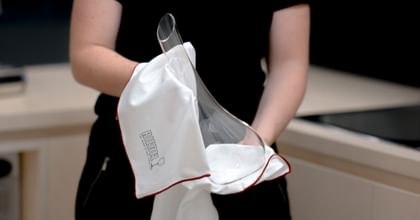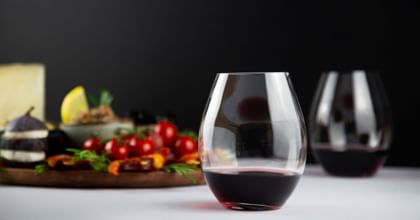How to get value for money when buying wine
Does Wine have to be Expensive to be Good?
_bearb.jpg)
To get a quality wine that your guests will love, you need to fork out a large sum of cash, right? Not quite. Learn how you can get a quality bottle of wine to impress your guests without breaking the bank, plus what you can do to get the most out of any bottle.
We've all been there; a special event is on the horizon and you want to purchase a good wine bottle for the occasion. The only problem is you're not sure exactly how much you need to spend to get something good that lives up to the event. You don't want to underspend and end up with a wine that falls short of expectations, but you'd also like to avoid overspending on a bottle if you can get a similar quality wine for a fraction of the price.
So, how much do you need to spend to get a wine that will dazzle your taste buds? Let's get into it.
.jpg)
What makes a wine 'good'?
Let's begin by briefly covering some factors that determine how good a wine is. The main qualities to look out for are:
- Complexity refers to the flavors and textures we experience on our palate from a wine. High-quality wines tend to be more complex, featuring numerous layers of flavor that develop on the palate. Lower-quality wines lack the same depth of flavor, instead often containing one or two dominant flavors.
- The balance between sweetness, acidity, tannins, alcohol, and fruit in the wine. Good wines are balanced so that none of these components overwhelm the others, creating a more palatable wine. That isn't to say all components are equal, but in a wine with a lot of tannins, for example, other elements are balanced to ensure the high tannins don't diminish the drinking experience.
- Clarity refers to the precision of the wine's flavors. Good wine exhibits clear, unmistakable aromas and flavors, while lesser wines are more likely to suffer from interference and disturbances in these qualities.
- Typicity refers to how much a wine's quality reflects things like the geography of where it was produced and other factors such as its vintage. Good wines reflect their varietal and geography in their qualities, whereas low-quality wines tend to lack distinctiveness.
- Intensity and finish. Typically, quality wines will display more intense flavors, while the finish lingers more on the palate after sipping.
While reputation and fame can contribute to the prices of wine bottles from certain regions and wineries, so do growing and winemaking practices that ensure a wine has an abundance of the mentioned qualities. Wines produced following rigorous canopy management, pruning, and precise harvesting, as well as thorough maceration, fermentation, extraction, and aging, will consequentially set you back more than wines that don't undergo the same thorough processes. How much more though?
.jpg)
Wine pricing
There is a huge variance when it comes to wine prices. The cheapest bottles in your local supermarket can cost $10 dollars, while high-end, premium bottles from your wine merchant can set you back hundreds.
Overall, you can expect to see a positive correlation between the quality of a bottle of wine and its cost. The cheapest wines you're likely to find are often made from a blend of several vintages, may have extra residual sugars added, and fall short overall in the qualities listed above. The good news, however, is that you don't need eye-watering amounts of money to get something that displays some of the hallmarks of quality winemaking and will impress your guests.
A comparison of prices and ratings of thousands of wines from online stores by wine marketplace Vivino found that a 'good' bottle of New Zealand wine (wines receiving at least 3.8 out of 5 stars from reviews) costs $60 on average for a bottle of red, and $25 for a bottle of white. Not necessarily cheap for many, but far from the jaw-dropping numbers you might have feared! It is typical for quality red wines to cost a little more than their white wine counterparts (and foreign wines can cost even more!), so this is something to remember when shopping around. Also note that restaurants typically mark-up bottles of wine by 200-300%, so that $30 Pinot Noir you found in your local store could cost somewhere around the $75 mark if you order it with dinner.
We've used prices in New Zealand for this example. Still, specific costs will vary from country to country, and inflation dictates that these figures are constantly changing. Affordability is also relative; quality wines from countries with less stable economies are often cheaper than wines of equal quality from a more economically prosperous country. The overall point though is that, while quality wine can cost a lot of money, a few tens of dollars or equivalent can be enough to get you a balanced, complex wine with typicity and terroir that you can enjoy on any occasion.
Get the most out of your bottle
How you store it after buying.
Wine lasts longer when kept in a cool, dark place - hence wine cellars! If your bottle has a cork, is it best to keep it on its side while it is unopened, as the interaction between cork and wine will allow the bottle to stay well sealed. Once opened, you can keep the wine fresh for a few more days by recorking or sealing it to limit further aging, keeping it upright to limit the surface area of the wine exposed to oxygen, and continuing to store it in a cool, dark place.
Serving it at the right temperature.
Red wines are best when enjoyed at between 54°F and 65°F/12˚C and 18˚C, with lighter-bodied red wines performing best at the cooler end of the scale and full-bodied wines at the warmer end. To achieve this, try refrigerating your reds for up to 30 minutes before drinking. If you have a wine fridge with temperature control, then even better! For white wines, enjoy them at between 46°F and 54°F/8˚C and 12˚C. White wine served straight out of the fridge is usually too cold, which can dull its flavors and aromas. To remedy this, take your white wine out of the fridge around 30 minutes before drinking, allowing it to warm up slightly to a more palatable temperature.
Letting it breathe.
Most relevant for young red wines (but not exclusively), you can allow your wine to develop the complexities in its flavors and aromas by allowing it to breathe and interact with air before drinking. One way of achieving this is by giving your wine a thorough swirl once you've poured it into your glass (and we advise you always do this), but for maximum effect, we recommend decanting your wine before anything else. Unfamiliar with this? Our guide to decanting wine details key information on the subject, including how to decant wines and why it matters.
Selecting the right glass.
Take the best bottle of wine you've ever had, drink it from a whisky tumbler, and ask yourself what happened to that rich, complex wine you previously enjoyed. That may be an extreme example, but using the wrong wine glass can have a similar outcome. It was in the 1950s that 9th generation Claus J. Riedel discovered the impact that the shape and size of your drinking vessel has on your perception of the wine it contains (spoiler - it has a big impact), and this philosophy has shaped our approach to glassware design ever since. There are various degrees to which you can tailor your glassware to the wine you're enjoying, which are covered extensively in our blog discussing Grape Varietal Specific glassware and wine-friendly glassware.
Locations


